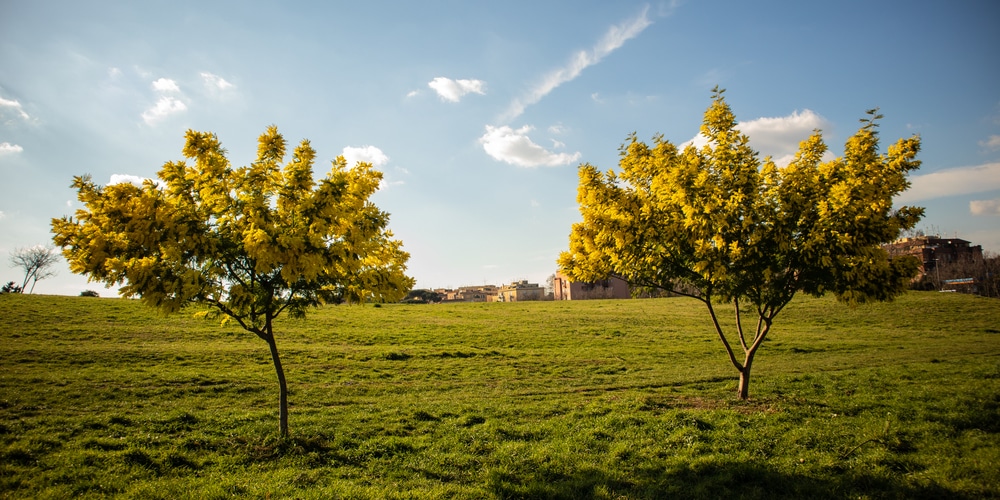Mimosa trees are one of the fastest-growing trees in the world. They can grow up to a foot or two per year in the right conditions!
A mimosa tree is an excellent option if you’re looking for an easy-to-maintain tree that grows quickly.
This article will discuss some more facts about mimosa tree growth and how to care for these beautiful plants!
Mimosa Tree: Growth Rate, Size & Lifespan

The Mimosa Tree is a fast-growing tree, gaining up to two feet of growth annually. Like most fast-growing trees, the mimosa wood is brittle, and branch attachments are weak. The tree typically reaches its full height within ten years but can live for over 20 years with proper care.
Size-wise, the Mimosa Tree typically reaches 20 to 40 feet in height and 20 to 30 feet in width at maturity.
When Does It Flower?
On the other hand, trees are grown from seed generally do not flower well until they are seven to ten years old.
The flowering season of the Mimosa tree is between late spring and early summer. The flowers are small and delicate, ranging in color from white to pink. They are typically found in clusters at the ends of branches.
How to Plant a Mimosa Tree
Plant mimosas in a sunny, well-draining location with plenty of growing room. If you’re transplanting a young tree, put it back at the same elevation as its previous position. Add compost or soil conditioner to the planting hole to improve drainage if the soil is tough.
When the soil is dry, water the sapling. Continue to do so until the roots have firmly established themselves. This should only take one year. Water the tree once it’s been watered, but only during severe droughts.
Mimosa trees are low-maintenance and require only a few years between fertilizations; you may use a general-purpose fertilizer every two or three years to keep them healthy. Make sure to follow the product’s recommendations for application rates and timeliness.
Pruning
Mimosa trees do not require much pruning, but you can remove any damaged or dead branches at any time. You may also want to thin out the branches to increase air circulation and sunlight penetration to the tree’s center. To do this, remove some of the secondary branches growing perpendicular to the main trunk. These cuts should be made just above a branch node (where the branch meets the trunk or another branch).
Mimosa trees also respond well to pollarding, a pruning method that involves cutting the tree back to just above eye level. Pollarding encourages the tree to produce new growth, which can be used for floral arrangements or other purposes. This method of pruning should be done every one to two years.
Pest And Diseases
Webworm, Spider mites, mimosa wilt, and cottony cushion scale are potential mimosa tree pests.
Mimosa wilt is a fungal disease affecting the tree’s leaves and branches. The leaves will turn yellow and drop off, and the branches may die. This disease is most common in trees stressed by drought or poor drainage.
Cottony cushion scale is another potential pest. This insect feeds on the tree sap, which can cause the leaves to be yellow and drop off. The scale is white and fluffy and can be found on the branches of infested trees.
Spider mites are tiny spider-like creatures that feed on the tree’s leaves. They can cause the leaves to turn yellow and drop off.
Webworms are caterpillars that build webs in the branches of the tree. They can cause the leaves to turn brown and drop off.
Treatment
Start planting mimosa trees in a sunny, well-drained location to prevent or treat these pests and diseases. If you suspect your tree is infested with spider mites, webworms, or cottony cushion scale, you can remove the pests by hand. You can also treat your tree with an insecticide. If your tree is infected with mimosa wilt, you can prune away the affected branches and destroy them. You can also treat the tree with a fungicide.
Conclusion
Mimosa trees are not for everyone. They have a very short lifespan, are susceptible to several pests and diseases, and can be invasive. The Mimosa Tree may not be the best choice if you’re looking for a low-maintenance tree that will provide years of enjoyment.
However, if you’re willing to take on the challenge, these trees can be a beautiful addition to your landscape. Just be sure to do your research and plant them with care.
Related Article: Five Trees With Fern Like Leaves

